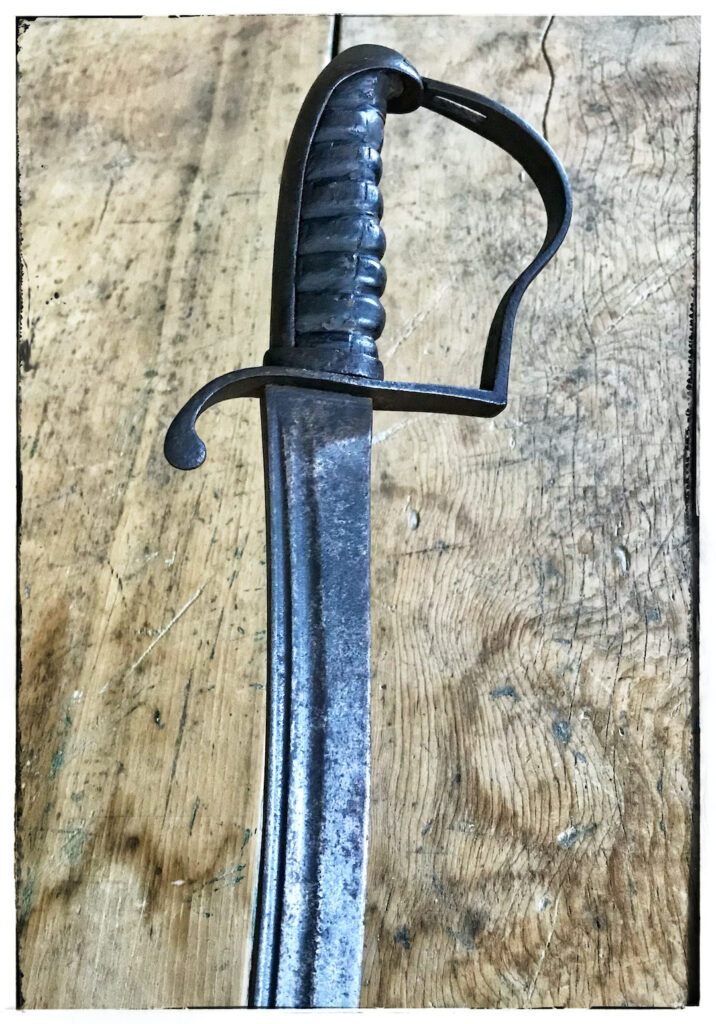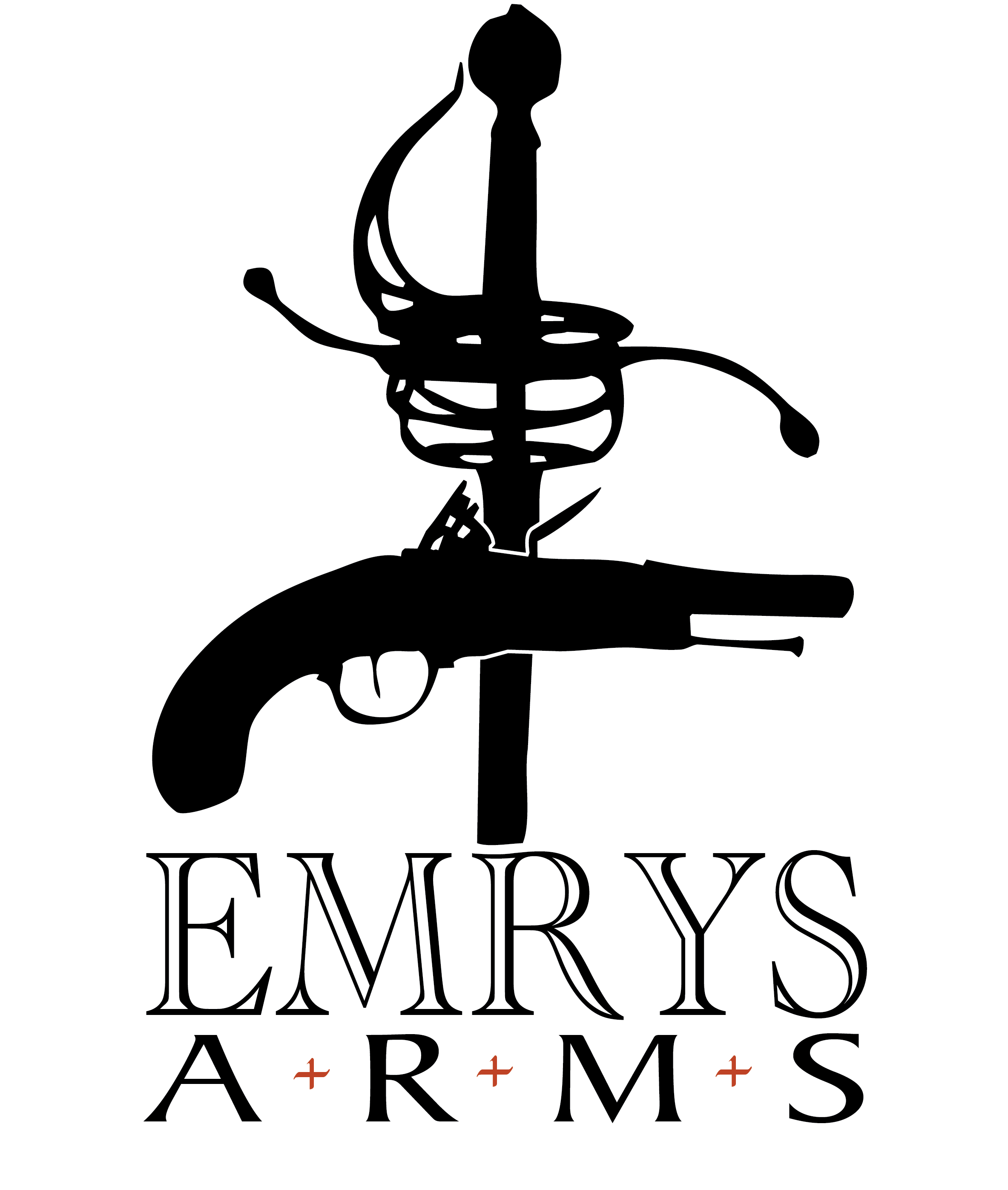| Collection #: | 2020.049 |
|---|---|
| Type: | Sabre |
| Nationality: | American |
| Pattern: | Artillery Sabre |
| Date: | 1807 - 1814 |
| Hilt: | Reverse P Stirrup Hilt |
| Blade Length: | 75cm (29.53") |
| Blade Width: | 3.5cm (1.38") |
| Overall Length: | 88.2cm (34.72") |
| Maker: | Virginia Manufactory |
| Blade Markings: | On the spine of the blade are the markings: 1 V |

At first glance, one might think of this sword as a version of the British 1796 pattern light cavalry sword – but there are subtle differences.
The entire sword (guard, blade, and grip) is a deep brown-black with age. There is no movement between the various parts of the sword.
The guard and grip. This sabre (like the 1796 pattern) consists of a reversed-P stirrup guard. At the top of the guard near the pommel is a rectangular slot for accepting a sword knot. The P guard inserts into the pommel, slightly up from the base of the pommel and then widens slightly to match the shape of the pommel. This is also a noticeable difference from the setup of the British 1796 pattern which tends to insert through a cut-out portion at the base of the pommel. The base of the guard does not have any langets. The quillon is slightly bent down toward the blade. The wood-carved grip is comprised of eight sections, the last of which curves under the pommel is only half there. Remnants of black leather or paint on the grip. The base of the grip contains a ferrule which measures about 0.8 cm.
Condition of the blade. A wide and narrow fuller starts at the base of the blade near the guard. The narrow fuller, between the wide fuller and the back of the blade, stops 14.5 cm from the tip. The wide fuller beneath the narrow fuller stops about 7.5 cm from the tip. It is possible that the 75 cm blade has been cut down from a longer blade. The blade has a slight bend to the right at about 13 cm to the tip. The very tip is slightly bent to the left. Near the tip is a circular hole in the blade which appears to have been filled with a copper plug. The spine of the blade at the forte is marked 1 V. The blade has a very fine edge to it.
Richard Bezdek in his book, Swords and Blades of the War of 1812 records this sword as an artillery sword made at the Virginia Manufactory in Richmond, Virginia. Between 1807 and 1814, somewhere between 2,010 and 2,040 artillery swords were made (the author quotes two differing amounts in two different books he produced).
Bezdek records that the Noncommissioned Artillery Officer’s sword regulations of 1801 stated that artillery swords were to have a brass guard. Rene Chartrand in his book A Most Warlike Appearance, also records that artillery officers were to have a cut and thrust sword with black leather scabbard and yellow (brass) mounts, NCOs to have the same as the infantry (a cut an thrust sword), but with brass guards. Unusually, these swords were produced with an iron hilt. Why is this unusual? Often artillery swords are created with brass hilts as iron hilts can create a spark when bumped against the wrong material – not a good situation when dealing with gunpowder.
These Virginia artillery swords are often identified as having a balled grip consisting of six central lumps – one on each end that disappears into the ferrule at the bottom and into the pommel at the top. The wood-carved grip would have been covered in leather. It has a reverse “P” type knuckle guard. However, unlike the more commonly found British 1796 light cavalry pattern, the knuckle guard inserts into a slot cut into the pommel. The British 1796 pattern guard attaches at the bottom of the pommel.
This model of sword consisted of two batches – those made specifically as artillery swords and those that were formerly first and second-pattern cavalry swords and were modified. The batch created directly as artillery swords typically have a less curved blade. Those that were modified cavalry swords, had their blades shortened to about 30 inches. The modified cavalry sword versions typically have a highly curved blade. On the spine of the cut-down blades can also be found markings to the 1st and 4th regiments of Virginia cavalry. This example is marked to the first regiment.
The scabbard of the sword would have been a leather scabbard with iron mounts. It would have had a frog stud to accommodate an over-the-shoulder strap. Unfortunately, this example no longer has its scabbard.
Harold Petersons book, The American Sword 1775-1945, shows an example of a Virginia Manufactory cavalry sword marked on the spine of the blade 1 Va REGt – adding additional evidence that this example is one of the cutdown cavalry blades. This example also has the 1 V but the remaining text is no longer legible.
According to Chartrand, Virginia contracted out their arms making at first but became frustrated by the lack of a private gun-making industry. The state legislature (in 1798) decided to allow the establishment of an armoury at Richmond which operated until 1821.
The first Virginia contract for swords was received in 1801. It was for 1000 cavalry swords and the contract was awarded to John Miles Senior. The swords were to be marked for the 4th Reg. Virginia Cavalry-Essex and 1st Reg. Virginia Cavalry-Dinwiddle.
Bezdek provides additional information reporting that the Manufactory became operational in 1801. It stayed in operation (to some degree) until it was torn down in 1900. Even though it existed for one hundred years, it only actively produced swords from 1804 until 1821. After this time it only refurbished swords.
Blades at the Manufactory were made from imported German steel. The artillery swords were primarily assembled from 1808 until 1821. As this is a cut-down cavalry sword, it may date a little earlier as the first and second model cavalry swords were made between 1805 and 1808. Assembly of the swords at the manufactory was discontinued in 1821.
Read the full accounts of what these authors have recorded, plus some other research or references on this pattern:
Bezdek, R.H. (1994) American swords and sword makers. Paladin Press, Boulder, Colorado, USA. Pages 50 – 51.
Bezdek, R.H. (1997) Swords and sword makers of the war of 1812. Paladin Press, Boulder, Colorado, USA. Page 22.
Chartrand, R. (2011) A most warlike appearance – uniforms, flags and equipment of the united states in the war of 1812. Service Publications, Ottawa, Ontario, Canada. Pages 120, 146-147 & 152-153.
Peterson, H.L. (2003) The american sword 1775-1945. Dover Publications, Mineola, NY, USA. Pages 26-27 & 38-39.
For further visual research, feel free to look up the following books for photos of other examples of this sword.
Bezdek, R.H. (1994) American swords and sword makers. Paladin Press, Boulder, Colorado, USA. Has photographs of the cavalry-hilted version, but not the artillery version.
Bezdek, R.H. (1997) Swords and sword makers of the war of 1812. Paladin Press, Boulder, Colorado, USA. Page 98.
Flayderman N. & Mowbray S.C. (1998) American swords from the philip medicus collection. Andrew Mowbray Publishers, Lincoln, R.I., USA. Pages 186 & 187 – an example with a mark of “3 Reg” on the spine of the blade.
Peterson, H.L. (2003) The american sword 1775-1945. Dover Publications, Mineola, NY, USA. Page 26, items 23 & 24 – for examples of the first and second pattern cavalry hilts, but also the style of blade on this artillery sword. Page 39, item 37, for an example of this artillery sword.
We use cookies to improve your experience on our site. By using our site, you consent to cookies. Enjoy the cookies...they're delicious...
Websites store cookies to enhance functionality and personalise your experience. You can manage your preferences, but blocking some cookies may impact site performance and services.
Essential cookies enable basic functions and are necessary for the proper function of the website.
Statistics cookies collect information anonymously. This information helps us understand how visitors use our website.
Google Analytics is a powerful tool that tracks and analyzes website traffic for informed marketing decisions.
Service URL: policies.google.com (opens in a new window)

